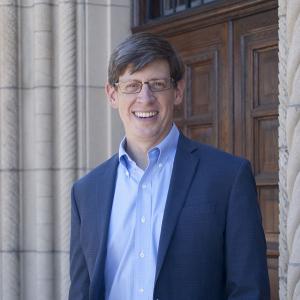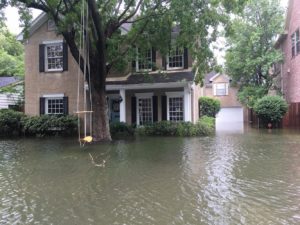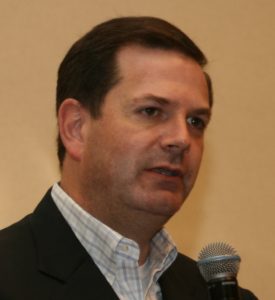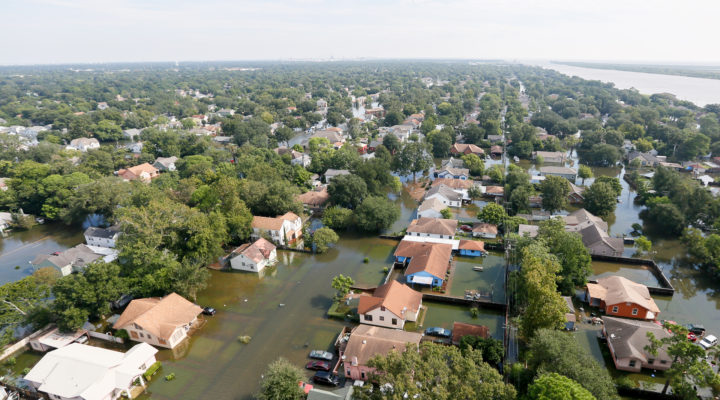On the outside, many of the Texas communities ravaged by Hurricane Harvey last year appear to making a comeback.
Repair and rebuilding work has been completed in many areas and blue tarps are becoming less common.
But on the inside, some survivors say, the emotional rebuilding is only just beginning.
“It’s still there. We are still working through this,” said Carey Cannon, the minister of music at South Main Baptist Church. He and his family lived with fellow church members until their flood-damaged home became available earlier this summer.

Carey Cannon (Photo/SMBC)
Cannon said he knows many others whose physical situations improved while their psychological states continue to lag.
“We are sleeping in our own beds now, and we are high and dry, but it’s still there.”
Harvey was there in a major way this time in 2017. The nation and the world watched in disbelief as the Category 4 storm first arrived in Texas on Aug. 25, then made landfall multiple times through Sept. 1.
A National Hurricane Center report estimated the damage at $125 billion, making it the worst hurricane after Katrina. The Houston Chronicle reported that 204,000 homes and apartment complexes were damaged. Tens of thousands had to seek shelter in shelters, hotels and neighbors’ homes even as the flood waters rose.
Government agencies like FEMA were joined in their response by faith-based groups across the religious spectrum in immediate disaster response efforts.
The Cooperative Baptist Fellowship and the Baptist General Convention of Texas were among those who stayed for the long haul. Many of their congregations, ministries and other agencies coordinated the repair and rebuilding of homes and churches – efforts which continue today.
And Harvey inspired people of different faiths opportunities to take in neighbors, sometimes for many months, as homes and livelihoods were slowly rebuilt.
Hurricane Harvey enabled the gospel to shine as a spirit of cooperation and compassion to the entire region, said Steve Wells, the pastor at South Main Baptist Church.
“It was the church of Jesus Christ in its finest hour.”
Cooperative, compassionate response
Last November, CBF and the Baptist General Convention announced they were partnering to rebuild churches impacted by the storm along Texas’ Gulf Coast.
Katie Sciba, a Texas Baptist and then a member of the Fellowship’s governing board, presented BGCT with a $50,000 check from CBF toward the rebuilding effort. She and her husband, Matt, were tapped to lead the project that also included the Hispanic Baptist Convention of Texas, the Blanco Baptist Association, CBF Texas, Fellowship Southwest, the Texas Baptist Architecture Team and CBF Global Missions.
“I am here today to announce a new way that we are working together to spread the love of Christ in the wake of Hurricane Harvey,” Sciba said in remarks published on CBF’s blog.
It’s been the same approach used in CBF recovery efforts employed in and around Houston.
Church groups from Texas to Massachusetts and places in between have streamed into the region to muck out houses and churches, rebuild drywall, organize clothing supplies, repair kitchens, roofs and greenhouses. In some cases, houses were rebuilt, according to information provided by Butch Green, the Houston-based CBF field personnel coordinating those efforts.
Visitors included volunteers from three colleges: Campbell University in North Carolina, William & Mary University in Virginia, and the University of Wisconsin. Altogether, 31 groups and 446 volunteers participated in CBF-coordinated recovery efforts.
Much of the work has been completed and the Houston-area efforts are slowly winding down, Green said. But many are not yet out of the woods.

Butch Green
“A lot of the needs have been met, but for years there are going to be people trying to rebuild and trying to get back to where they were before,” Green said.
Much of that is due to continuing financial hardship.
“Financially, a lot of people are still struggling and for those people, it’s been difficult,” he said.
And some of that has to do with insurance issues.
“It’s not just the poor and people who didn’t have insurance,” he said. “There are even some people who are pretty well off who are not completely back yet.”
Still a lot of healing to do
Those observations already are being supported by scientific research.
In May, the International Journal of Environmental Research and Public Health published preliminary data showing that Hurricane Harvey caused significant mental health challenges.
Completed questionnaires showed evidence of post-traumatic stress disorder, depression and generalized anxiety disorder, according to the paper.
It’s no wonder that even those who have moved back into repaired or rebuilt homes have continued to struggle with strained relationships, divorces, unemployment and other side effects of the storm, Cannon said.

Carey Cannon’s home in Houston after Hurricane Harvey. (Photo/Courtesy of Carey Cannon)
“A lot of people are just sort of shell shocked. They are mental cases,” he said.
Many wrestle with guilt – guilt from having to live in a neighbor or church member’s home for months on end. Some feel guilty having a home untouched by the hurricane and floods while neighbors lost everything. Others feel badly that their renovated homes are better now than before the storm, he said.
Wells said others were ashamed they had to charge their newly homeless neighbors or fellow church members rent for temporary housing.

Steve Wells
A lot of children continue to suffer from trauma and panic every time it rains, Wells said, adding the entire region dreads the next time a tropical storm or hurricane forms in the Gulf.
Cannon said his own son, who was 8 when Harvey struck, became repeatedly anxious while the family lived with another church couple for 10 months.
“He would break down,” he said. “He was afraid his behavior would get us kicked out.”
Wells, who welcomed neighbors into his undamaged home after the storm, said many people are worn down by battling insurance companies and government agencies for funds. The entire region, he said, is just exhausted.
But many also are encouraged by the way religious groups rallied to their communities’ rescue.
They saw teams of volunteers helping with material and spiritual needs immediately after and for months after the catastrophic event, Wells said.
“When it floods, the whole system is overwhelmed,” he said. Who do you see coming to the rescue? The church.”
And it’s a good thing, Cannon added, because there is still a lot of emotional healing to do.
“Families are still having to process the impact of the storm,” he said.
Contributions to CBF disaster response may be made here.
Related stories:
Ministry unfolds ‘on the cellular level’ for those in Harvey’s path


